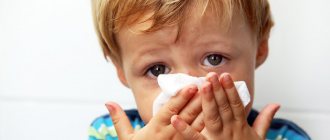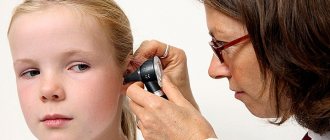A runny nose that occurs in children causes a lot of problems and troubles for kindergarten teachers and parents. One of the most common diseases during the cold season is a runny nose, or rhinitis, an inflammatory disease of the nasal mucosa. First of all, you should understand the possible causes of this disease in children.
Types of runny nose and causes of rhinitis in children
Rhinitis is often a symptom of a more dangerous contagious infection, such as influenza or tuberculosis. There are two forms of the disease:
- Non-infectious. It, in turn, is divided into non-allergic and allergic rhinitis. The latter is caused by allergens that enter the body along with food or through the nose, less often when a person comes into contact with chemicals. Common allergens include fungal spores, plant pollen, dust, animal hair, and mold.
- Infectious. As a rule, these are rhinitis associated with other, more dangerous diseases, such as acute respiratory viral infections, influenza, and colds.
In addition to infections and allergies, a runny nose can be caused by characteristic changes in the nasal cavity, such as a deviated septum, polyps, deformation outside and inside the organ. Hormonal changes in a child's body occur, for example, when using strong hormonal medications or when exposed to irritants such as dust, soot, gases and chemicals that irritate the nasal mucosa without the addition of an allergen.
Long-term use of certain drugs also causes illness in children. For example, the use of topical decongestants can lead to incurable dystonia of the nasal vasculature. Hypothermia of the body, wet feet, clothes, drafts, sudden temperature changes are the most striking causes of non-infectious and non-allergic runny nose.
Hereditary predisposition or chronic breathing disorders, traumatic injury to the nose, foreign objects entering the nasal cavity - this is an incomplete list of reasons that can cause a runny nose in a child at any time of the year. Only a doctor can tell you whether to take a child with a runny nose to kindergarten.
Snot is not a problem, the problem is its treatment! The modern approach of Dr. Komarovsky.
Diseases Children Women Lifehacks Runny nose Prevention Parents
A child's runny nose is, of course, unpleasant, but even worse is not knowing how to deal with it and whether it is worth fighting it at all! It turns out that there is no need to rush to close the nursery for quarantine just because the child’s nose is running.
Evgeny Komarovsky explains: “Children are not afraid of snot, children are afraid of snot treatment!” He assures that it is possible to send children with a runny nose to kindergarten and school if you know how! Isolation of a child can be avoided if you understand the reasons.
Runny nose in children
“When answering the question of whether a child can go to kindergarten with a runny nose, one must take into account that there are allergic, bacterial and viral runny noses. Theoretically, even if a child has a constant runny nose, the doctor should write “respiratory runny nose” in the diagnosis, and with such a runny nose, the child, of course, can go to kindergarten,” the doctor reassures, examining the types of runny nose in more detail.
- Allergic rhinitis Such a runny nose does not pose a danger to others. It is caused by dust, fur and other irritants. In this case, the discharge is transparent - it is useless to treat it with anti-cold medications.
- Bacterial runny nose With this type of runny nose, the snot takes on a green tint, but is often associated with a lack of moisture rather than anything serious. In this case, humidifying the room or rinsing the nasopharynx with saline solutions will help. In this case, a runny nose is also safe for others.
- Viral runny nose And only this type of runny nose is contagious. It all starts with fever and burning in the nose, often accompanied by a bacterial infection, so the snot turns green. However, with a mild form, this should not prevent the child from fully attending kindergarten and classes! It is a viral runny nose that helps children exchange infections and tolerate them in a mild form to avoid complications in the future. You just need to remember the correct ratio of temperature and humidity, and then your baby’s immunity will only get stronger!
Watch a short video in which an outstanding doctor will dot the i’s!
Evgeny Komarovsky ends on an optimistic note: “I hope that something will change in this regard. Not attendance at kindergartens and schools, but the attitude towards snot. Snot is an attribute of childhood; it doesn’t need saving.”
Therefore, we wish you good health and less worry over trifles! Know that you can get rid of a runny nose without medication, and so that your loved ones also sleep peacefully, share this useful article with them!
takprosto.cc
Is it worth taking a child with a runny nose to kindergarten?
Each parent has the right to decide for himself whether he is ready to send his child with a runny nose to kindergarten or not.
Experts believe that if the disease is caused by non-infectious factors, such as allergies or a nasal injury, then you can safely go to kindergarten with a runny nose. If a child experiences a deterioration in health or a high temperature, or has complaints about other primary symptoms of infectious diseases (cough or chills), you should immediately contact your local pediatrician rather than go to kindergarten.
A runny nose associated with an infection is, firstly, contagious to other children. Secondly, continuing to take a child with a runny nose to kindergarten, there is a chance of getting various complications, ranging from chronic otitis media to deterioration of the immune system. By carrying out simple preventive and therapeutic procedures at home, a child on bed rest can be quickly put back on his feet.
Is it possible to go to kindergarten if a child has snot?
The child has snot: we are staying at home
According to sanitary and hygienic standards in force in the Russian Federation, only absolutely healthy children are allowed to attend preschool and school institutions. You cannot go to kindergarten with any symptoms of ill health, such as rhinitis (snot), cough, fever, vomiting, diarrhea, itchy skin, etc. If one of the parents violates this rule and the administration of the preschool institution allows this to happen, you can file a complaint with the department of education or health of the city, region or territory in which you live.
The child has snot: we make a diagnosis
First you need to figure out the origin of the child’s snot. Doctors call minor, most often colorless and thin nasal discharge rhinitis. Only viral (most of them) and bacterial rhinitis are contagious. But in the first year of attending kindergarten, a child “has the right” to get a viral infection up to 12 times. Therefore, the world has taken it as an axiom: the presence of only rhinitis and good health allows you to attend kindergarten; there are also other symptoms - stay at home. Well, in our country, the decision to admit a child with a runny nose into the group or not is made only in a private kindergarten, and only by a joint decision of the parents. In the state, the rules mentioned above should apply.
Favorable exchange
...I believe that children should change through infection, and a child’s snot is not a reason not to communicate with peers. If there is no fever or cough, then take the child and ask the teacher to blow his nose. My son didn’t blow his nose like that once – he started having bronchitis. Now, when there is snot, I wash his nose in the morning and, if he is not choking on the snot, I take him to kindergarten. If I see that I’m very snotty, we sit at home for two or three days...
There is both a rational grain and an erroneous conclusion in this statement. Let's start with the right thing: when you start visiting kindergarten, the likelihood of contracting various infections increases many times, since each person represents a unique combination of microbial agents that the child has not yet encountered. Hence the increase in the incidence of respiratory infections. It’s bad when the baby is sick, but such a “minus” also carries with it a lot of positive things, because for the normal functioning of the child’s immune system it is necessary to train it, to develop so-called memory cells that will allow the baby, upon repeated contact with the infection, to defeat it and not get sick. And this requires regular “meetings” with various viruses and bacteria. Only in this way can immunity become a truly protective system for the child, stable and reliable. And now about where the mother giving this advice is mistaken. It is clear that the nasal passages must be regularly cleared of mucus, otherwise the child will breathe through the mouth. But the transition from a runny nose to bronchitis is not due to the fact that the little one did not blow his nose. But for another reason. This is a completely natural development of ARVI occurring in a child with weak immunity who is not treated correctly. Hence the complications. And you should not rinse your nose if you have a severe runny nose. A salt solution, even a weak one, as well as a physiological one, will dry out the mucous membrane even more. And the baby’s condition will worsen. And then complications are not far away.
A child has a runny nose: learning to blow his nose
...We have a municipal garden, and it depends: when a lot of children are snotty, they don’t blow their noses, when there are few, they wipe it. But my child asks me to wipe his snot...
A child under four years of age will not be able to clear mucus from the nasal passages by blowing his nose or rinsing. A nurse or doctor should come to help. Only they have the right to carry out such manipulations by law. Neither educators, nor nannies, nor teachers have such a right.
Green melancholy
...For the younger group, green snot is considered the norm. In my daughter’s group, I never agreed to leave her at home with her snot. Not everyone has the opportunity to leave their child at home, so they bring in an untreated child...
A protracted and already complicated bacterial infection of the ENT organs is always accompanied by the discharge of a greenish or yellowish purulent secretion from the nasal passages. Almost always, in addition, there are also signs of intoxication, cough, increased body temperature, and chills. And in this case, a visit to the doctor and a correct diagnosis is required. What if it’s no longer rhinitis, but sinusitis or sinusitis?! They, in fact, are also runny noses, but the inflammation goes deeper into the sinuses. Without proper treatment for a bacterial infection, various complications can occur.
Continuous flow
...Depends on the child. Someone sniffled and withered, while another blew his nose and continued playing. But the snot in the group in winter does not translate in any case...
Susceptibility or resistance to infection, the speed of recovery, whether the child recovers from the disease with complications or not, depends primarily on the state of the immune system, the nature of nutrition, and the presence of concomitant diseases.
Snot in kindergarten. Humble yourself!
...News. Otherwise, you can sit at home endlessly. But watch out. Green snot is no longer good. You should call a doctor here. My son always has five people in his group with a runny nose. My parents say honestly: we don’t have the opportunity to leave them at home. So even if you are conscious at least a hundred times, it’s still inevitable that children with snot in the group...
The child should be surrounded not only by loving relatives, but also by peers. Only the same level of development, common interests, games and sometimes even snot and conflicts can “teach” a child and his immune system to behave correctly in society. In modern preschool institutions, municipal or private, children are not only fed, taken for walks and put to bed after lunch. Special educational programs have been developed for each age, thanks to which the child “grows up” to school, already possessing a considerable amount of knowledge. Well, and a strong, hardened immune system, of course, too.
Is a child’s runny nose nonsense?
...Snot is not a disease at all. It will go away on its own...
Snot, also known as rhinitis, is certainly a disease, and quite a complex one, since it most often leaves consequences and gives complications. The disease begins as a superficial inflammation of the nasal cavity. And it is not always possible to establish its cause. There are many options: bacteria, viruses, allergies, vegetative-vascular dystonia, disruption of the structure of the nose itself. Ideally, due to the law of nature, thanks to which the mucous membranes are often renewed, some rhinitis disappears in 10–14 days on its own. But more often than not, this problem does not go away, and especially with children due to the structural features of the respiratory tract. They are too small, the virus or infection quickly moves into the nasopharynx and to the hearing organs. And of course, allergic and vasomotor (due to weakness of the nasal vessels) rhinitis never go away on their own. They can last for months and sometimes years.
It's better to play it safe
...I don't drive for two reasons. To avoid getting a secondary infection and because we are against children with runny noses in the garden and infecting others. Everyone reacts differently to an infection: if one has a mild form, it is not a fact that the child he infects will not have a severe one...
There are no children who do not begin to get sick more often with the beginning of their “kindergarten” life. Someone gets sick in the very first days, as soon as he was brought into the group, someone can hold out for two weeks. Some children get sick every month, while others get sick less often. The severity of the clinical picture also differs: from a slight runny nose with light clear snot to the development of a full picture of acute respiratory viral infection with fever, severe runny nose and intoxication. To make it easier for a child to tolerate a respiratory infection, it is necessary to take care of proper prevention, namely proper nutrition, hardening, vitaminization, aromatherapy and vaccination.
Tips for preventing runny nose in children
Any illness in a child, be it nasal congestion, cough or general malaise, must be diagnosed at an appointment with a pediatrician and then treated. An neglected childhood disease can quickly develop into a chronic illness, which will subsequently make itself felt in adulthood.
It is not difficult to cure incipient rhinitis in a child, but it is much easier to prevent it. It is necessary to be warm, but dress your child according to the weather when going to kindergarten, without wrapping him up too much to avoid excessive sweating.
Particular attention should be paid to shoes: they must be waterproof, with protective impregnation against moisture and dirt. Inside the shoes there should be a fur fleece (preferably made from sheep's wool) and warm insoles that can always be taken out and dried.
It is also necessary to monitor the child’s general immunity. It is recommended to take him for long walks in the fresh air in the park or in the forest, to teach him to lead an active lifestyle and play sports from childhood. Don’t be afraid to send your child to sports clubs and clubs.
Nutrition also has a huge impact on the child’s immunity and well-being. The daily menu should include fresh vegetables and fruits, dairy products, meat, and fish. Foods with unnatural ingredients, such as soda, candy, and chips, should be avoided.
The room where the child lives must be constantly ventilated for 10-15 minutes a day. You should wipe off dust and wash the floor with a disinfectant. At the same time, children themselves must be taught cleanliness and the rules of personal hygiene.
The child should know that they should always keep their hands clean, wash fruits, berries and vegetables before eating, and not play with dirty toys.
Causes of a constant runny nose
Every parent tries to protect their child from all kinds of risks and diseases. Therefore, when snot appears in a baby, the question always arises: what caused its appearance? In fact, there are a lot of factors influencing nasopharyngeal congestion. But basically, a runny nose appears from viruses entering the nasal mucosa.
The main causes of a constant runny nose in a child include:
- overheating or hypothermia of the baby (you need to ensure that the baby’s clothes correspond to the temperature conditions indoors or outdoors);
- reaction to chemical or mechanical substances (air pollution, dust, emissions, etc.);
- allergic reaction to animals (cats, dogs, parrots, etc.);
- identification of pathology of the paranasal sinuses;
- infection entering the body;
- unsuitable climatic conditions for the child.
The causes of runny nose in infants are completely varied. Its duration may also depend on the time of year. For example, in autumn or winter, frequent snot can occur as an independent disease. During this period they are caused by a sharp cold snap. And since infants have too weak an immune system, they are more susceptible to hypothermia than other people, which results in the development of colds - ARVI or acute respiratory infections. At the same time, do not forget that children with a stuffy nose eat and sleep very poorly.
How to quickly cure rhinitis in children
If your baby does get sick, don’t panic. A runny nose and other viral diseases can be treated quickly, and if you follow the above rules for the prevention of rhinitis, the disease will pass without complications.
The first thing to do in case of primary manifestations of a runny nose is to measure the child’s body temperature. If the thermometer shows 37.6ºC or higher, then you need to immediately consult a doctor. Most likely, with such symptoms, a runny nose is due to an infectious pathogen of the disease.
In this case, treatment of a runny nose will be of a secondary nature, and the main task is to extinguish the viral focus in the body.
Pathological causes
Most often, persistent snot in a child is caused by the following processes:
- adenoiditis - inflammation of the retropharyngeal tonsil;
- otitis – inflammation of the middle ear, from which pathological discharge can easily enter the pharynx and nasal cavity;
- sinusitis - bacterial infection of the maxillary paranasal sinuses (this process practically does not occur in children under 3 years of age, since the sinuses are not yet developed);
- chronic inflammatory diseases of the laryngopharynx;
- frequent colds and weakened immunity;
- prolonged and uncontrolled use of vasoconstrictor nasal drops;
- deviated nasal septum or congenital anomalies in the structure of the sinuses;
- passive smoking – if a child is constantly forced to breathe cigarette smoke.
Depending on the nature of the origin of the runny nose, it can be:
- viral;
- bacterial;
- allergic.
In some cases, inflammation of the mucous membranes in the nose can be caused by traumatic tissue damage, for example, when small toys get into the nose, unsuccessful cleaning, or inserting fingers and sharp objects into the nasal cavity.
Symptoms of a viral runny nose
Ordinary acute rhinitis develops as a result of viruses entering the mucous membranes, which penetrate into epithelial cells and begin to actively multiply there. Often in children, an acute runny nose occurs in parallel with inflammation of the retropharyngeal tonsil (adenoids), tonsillitis, and pharyngitis.
Viral rhinitis is characterized by nasal congestion, abundant clear mucous discharge, redness of the skin around the vestibule of the nasal cavity, and impaired breathing as a result of tissue swelling.
Runny nose of bacterial origin
Bacterial rhinitis is a consequence of a complicated or untreated acute runny nose and is characterized by the addition of a secondary bacterial infection and the development of a sluggish inflammatory process, both in the nasal cavity itself and in the nearby paranasal sinuses.
In this case, the discharge acquires a thick consistency, a yellow or greenish tint, becomes mucopurulent or purulent, and may have an unpleasant odor.
Breathing through the nose is impaired, the child constantly has snot, and during sleep he may snore and cough due to mucus draining down the back wall of the throat.
The inflammatory process alternates between periods of improvement (when the immune system strengthens and is able to restrain further proliferation of microorganisms) and relapse (when, under the influence of external factors, such as hypothermia or too dry air, the defenses are weakened and bacteria begin to multiply again).
Allergic reaction
Allergic persistent runny nose in a child can have either a periodic course or a chronic course, depending on the nature of its origin. For example, if rhinitis is caused by the flowering of ragweed or poplars, then a runny nose will appear in the summer and continue until autumn.
If the allergic form of the runny nose is caused by exposure to house dust, mold (lives in all homes without exception), household chemicals or pets (their fur), then nasal discharge will be constant and year-round with short periods of remission (improvement).
A persistent runny nose of an allergic nature is characterized by the following symptoms:
- itching in the nose;
- severe tissue swelling and inability to breathe normally;
- nasal voice;
- sneezing;
- sore throat;
- lacrimation;
- cough, during which a small amount of viscous, transparent sputum is released.
You can only get rid of allergic rhinitis if you establish the cause of the pathology (carry out a skin test for allergens), and then avoid contact with the pathogen.
Remedies to help cure a runny nose and relieve symptoms
The most popular remedies are:
- Vasoconstrictor drugs. Such products are ideal for very young children, because... Available in convenient packaging in the form of drops or sprays. But they can only relieve symptoms such as itching and nasal congestion. The maximum period for using such drugs is no more than 7 days.
- Inhalations. A safe and accessible folk method that is familiar to everyone since childhood. Our grandmothers also recommended breathing over potatoes or hot water, and when you add soda, chamomile decoction or pine buds, this method of getting rid of a cold becomes not only useful, but also pleasant. It is important to follow some safety practices, such as wrapping a hot pan of inhalation liquid tightly with a towel or blanket to prevent the child from getting burned. The procedure takes 10 minutes. You need to breathe alternately through your nose and mouth. Upon completion of inhalation, wipe the child dry with a clean towel and change into dry, warm clothes.
- Nasal rinsing. Using this method, they effectively fight against viral runny nose. Accumulating mucus during the procedure must be constantly eliminated, otherwise stagnation of mucus will cause diseases such as sinusitis and frequent headaches. The nose should be washed with a solution of table salt or chamomile decoction 5 times a day, morning and evening. After rinsing, drops for a runny nose should not be instilled immediately, because at this time, strong mucus separation begins. You should blow your nose thoroughly and wait about 30 minutes.
- Use of medicated oils and ointments. Active homeopathic remedies are oils from plants such as echinacea, eucalyptus, and aloe. Here it is important to check whether the child is allergic to a particular drug. You need to instill 2-4 drops of heated oil, after which you should tilt the child's head down. This will allow the oil to penetrate into distant areas of the nose.
Be healthy and don't miss kindergarten!
Causes and mechanisms
The main problem with the protracted course of the inflammatory process in the nose is to determine its origin. Indeed, if the source of the pathology is incorrectly identified, even the most modern treatment will be ineffective. The causes of a runny nose in children can be different. Firstly, frequent rhinitis is a consequence of respiratory viral infections. Then we are talking about reducing the body’s immune reactivity, and therefore its ability to resist infections.
Secondly, the problem may be chronic. But here it is not so much infectious agents that are involved, but other unfavorable factors:
- Structural abnormalities (deviated nasal septum, congenital defects, consequences of fractures, foreign bodies).
- ENT diseases (adenoids and polyps, sinusitis, tonsillitis).
- Irritating agents (cigarette smoke, dust, dry hot or cold air, chemicals).
- Sensitization of the body to allergens.
- Uncontrolled use of vasoconstrictor drops (decongestants).
Harmful aerosols and dust can cause first acute and then chronic inflammation of the mucous membrane. They lead to disruption of the outflow of secretions from the nasal cavity due to the death of the ciliated epithelium. Ventilation disorders occur when volumetric processes interfere with the passage of air (adenoids, polyps, foreign bodies), and long-term pathological processes in other parts of the respiratory tract only support constant inflammation of the nasal mucosa.
Special mention should be made of allergic rhinitis. It is of non-infectious origin, and swelling and hypersecretion of mucus are caused by the production of histamine, serotonin, and bradykinins. These substances increase vascular permeability and are responsible for the appearance of other allergy symptoms. And the cause of such sensitization can be various antigens that surround the child in everyday life (food, animal hair, plant pollen, medications, chemicals). Vasomotor disorders may have a neuro-reflex mechanism, occurring in response to inhalation of cold air, strong odors or stress. In turn, this is also accompanied by quite violent manifestations from the nasal mucosa.
If a child has a constant runny nose, then first of all the cause of the disorder should be determined. There may be several conditions responsible for this phenomenon.










